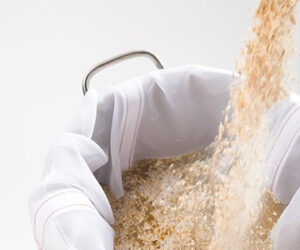Force Carbonation: Tips from the Pros
Brewer: Brad Fournier
Brewery: Birmingham Brewing in Birmingham, Ala.
We force carbonate by injecting carbonation into the beer in an almost liquid form. We carbonate to about 2.4 volumes (medium carbonation). It doesn’t take very long, and it’s easy. Whether or not this is better or worse than natural carbonation is entirely subjective.
Some brewers think force carbonation is easier because you can carbonate the beer in an hour and you can control the exact volume (carbonation level).
Carbonating naturally is easy, too, but can require additional equipment. I have carbonated naturally at other breweries using the spunding method. This method traps the carbonation in the beer during the last stages of fermentation. For example a typical German brewer might transfer the beer to the secondary once it’s 60 percent or more fermented. As a rule of thumb, most brewers will transfer when the beer is one to two degrees Plato (four to eight specific gravity points) away from final fermentation.
At this point the yeast is still producing carbon dioxide. By maintaining top pressure on the secondary fermenter (as well as a cool enough temperature) the CO2 will dissolve into the beer, creating the carbonation.
The higher the top pressure, the more dissolved CO2. The higher the beer temperature, the lower the amount of dissolved CO2.
The secondary container we used was our lagering tank. We put a fermentation lock onto the tank, which allowed us to maintain and control the top pressure on the beer. The regulator released the excess CO2 created by the fermentation to maintain 10 psi. Because we controlled the pressure and temperature, we could create and maintain the correct level of carbonation.
There are ways to avoid over-carbonation. Some brewers will tap the beer between two plates that inject CO2 into the beer. We’re just careful not to carbonate for too long. We check the carbonation level of the beer, say every five to 15 minutes, depending on how close we are to establishing carbonation.
Homebrewers can also control carbonation, depending on the carbonation method they employ. The spunding method is fairly easy because you can transfer your beer fairly early into a lagering tank and still have the beer ferment just fine. You don’t have to worry about how high or low the carbonation is because you have a pressure regulator. I wouldn’t recommend this method for use at home. It requires a pressure vessel and a very reliable regulator. You can’t just use a standard keg regulator.
Many homebrewers naturally carbonate with kraeusen (scooping the foamy peaks that appear during the height of fermentation and using this yeast-filled substance to carbonate another batch of beer) or priming sugar. One thing about priming or kraeusening to keep in mind is the nutritional needs of your yeast, even in that late stage of fermentation that produces carbonation in the bottle. Yeast will produce off-flavors if it doesn’t have enough nutrition while it’s fermenting.
To that extent I would say kraeusening is preferable to priming using corn sugar because kraeusen, which is usually unfermented wort, supplies proteins and other things that yeast need. You’ll find you have more esters (fruity flavors) if you use corn sugar.
When priming with sugar or kraeusening, one of the most important things to keep in mind is making sure you have a high enough yeast count for your priming sugar or for your kraeusen to turn into carbonation.
If you decide to kraeusen and don’t have a way to release CO2, then CO2 is directly proportional to the amount of sugar used to supply yeast. Keep in mind the beer’s temperature. You can’t possibly establish natural carbonation with an ale strain of yeast at 60° F.
If you’re applying any type of lager strain, you want to be sure to keep the fermentation temperature cold or at the standard lager temperature, usually between 5° to 7° C. You have to know the restrictions of your yeast strain.
When artificially carbonating in a Cornelius keg, always be sure to stay below the maximum tank pressure. Overcarbonation in the keg happens when you make a mistake — it’s just operator error. The same can be said for carbonating with the spunding method.
There’s really no way to go beyond a certain (inadequate) level of CO2 if you don’t give the yeast enough sugar to ferment or if you don’t supply the tank with enough pressure.
One advantage to artificial carbonation is that you don’t have to worry about maintaining the correct temperature for the yeast. Lower the temperature if you need to increase the CO2.


